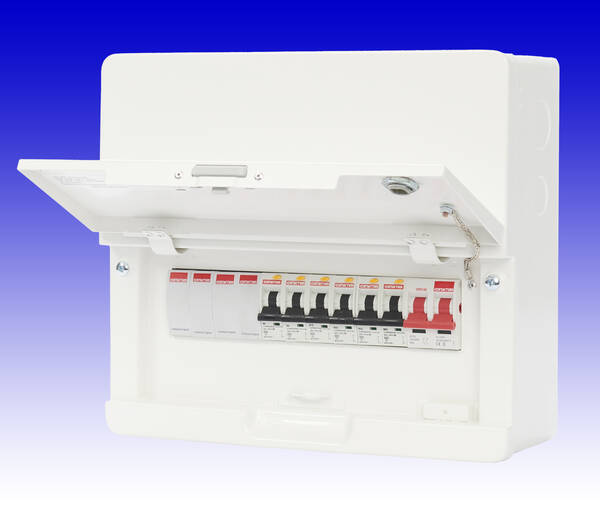The Function of Customer Units in Reliable Energy Administration Solution
Customer devices are indispensable to effective power administration systems, serving as the primary distribution factors for electric power within frameworks. The introduction of wise technologies has actually further improved their performance, allowing for real-time information monitoring and nuanced energy consumption evaluation.
Recognizing Customer Systems

Comprehending the duty of consumer devices begins with recognizing their important function in protecting electric systems. By separating faults within details circuits, consumer units stop extensive blackouts and possible fire risks. This seclusion is achieved with using circuit breakers that journey or fuses that blow when a mistake is spotted, thereby reducing off the electrical flow to the influenced circuit.
Additionally, consumer devices promote the orderly distribution of power, boosting the effectiveness of energy usage. They allow for the organized administration of electrical tons, which can be especially crucial in industrial and industrial setups where need can rise and fall dramatically. Correctly maintained consumer devices add to the long life of electrical systems and help in lessening downtime caused by electric failures, ultimately sustaining the seamless procedure of energy-dependent centers.
Smart Technologies Combination

A crucial advantage of smart consumer devices is their capacity to take advantage of progressed algorithms and artificial intelligence for predictive analytics. This permits for preemptive adjustments based upon usage patterns, weather report, and other variables, dramatically increasing total performance. Furthermore, wise consumer devices promote need action programs, where power usage can be dynamically readjusted during top periods to maintain the grid and minimize costs.
The integration of sustainable power resources, such as solar and wind, is additionally streamlined with smart customer systems. By intelligently taking care of the intermittency of these sources, these devices ensure a well balanced and reputable energy supply. Additionally, clever consumer systems boost individual involvement by giving in-depth understandings and push-button control capacities through mobile applications, cultivating an extra aggressive approach to energy conservation and sustainability.
Tracking Energy Consumption
Building on the capabilities of smart innovations assimilation, keeping an eye on power intake comes to be a crucial focus within energy administration systems. Efficient surveillance works as the structure for determining energy ineffectiveness and applying rehabilitative actions. By leveraging sophisticated metering infrastructure (AMI), real-time data on energy use can be gathered at granular levels, giving useful insights right into usage patterns and peak demand durations. This data-centric technique allows both consumers and energy supervisors to make informed decisions targeted at lowering waste and improving overall performance.
Smart meters and Web of Things (IoT) gadgets play a critical duty in this monitoring process. These gadgets can track power use in real-time, transmitting information to central systems for evaluation.
The combination of these technologies not only empowers customers with in-depth info regarding their energy usage but likewise sustains energy providers in handling load distribution better. Inevitably, accurate and continual tracking is important for achieving power efficiency, price financial savings, and sustainability goals within power administration systems.
Optimizing Appliance Usage

One reliable technique includes determining top and off-peak hours to change energy-intensive tasks, such as laundry or dishwashing, to times when energy demand is lower. This not just minimizes stress on the grid but additionally profits from reduced energy tolls. Additionally, incorporating artificial intelligence algorithms enables predictive maintenance, ensuring home appliances operate at ideal effectiveness and extending their lifespan.
Energy management systems can also integrate user-specific preferences and behaviors to tailor device use routines. Clever illumination systems can adjust illumination based on occupancy and all-natural light schedule, while HVAC systems can maintain comfort levels without too much power usage.
Encouraging Sustainability
Promoting sustainability within power management systems includes not just improving performance but likewise cultivating environmentally liable methods. Bonuses Consumer systems are essential to this process, as they provide real-time information and control systems that enable customers to keep track of and decrease their power intake. By leveraging advanced modern technologies, customer devices can recognize energy-saving opportunities and help with the assimilation of renewable resource sources like solar and wind power.
One crucial facet of advertising sustainability is informing consumers on the benefits of liable power usage. Via detailed understandings provided by consumer systems, users can make educated choices that minimize their carbon footprint. As an example, these systems can suggest ideal times for operating high-energy home appliances based upon grid need and renewable resource accessibility, consequently decreasing reliance on fossil gas.
Furthermore, consumer units support the adoption of wise grid innovations, which enhance the total performance and reliability of power circulation. By allowing two-way communication in between consumers and utility carriers, these systems can dynamically adapt to power demands, decreasing waste and promoting the usage of sustainable energy practices.
Final Thought
Customer devices, as integral elements of power management systems, dramatically improve electric safety and effectiveness within buildings with circuit protection and wise technology combination. Additionally, the consolidation of eco-friendly energy sources promotes lasting techniques, adding to reduced general power intake and reduced carbon footprints.
Developments in clever technologies have changed the capabilities of energy administration systems, particularly through the assimilation of smart consumer devices.Building on the capacities of wise technologies combination, keeping track of power consumption comes to be a vital focus within energy administration systems.Efficient device use optimization is an essential part of power monitoring systems, intending to boost see this page performance and lower unneeded power intake.Consumer systems, as important parts of power management systems, considerably boost electric safety and efficiency within buildings via circuit protection and smart technology integration. Furthermore, the incorporation of sustainable power resources advertises lasting techniques, adding to reduced overall energy usage and reduced carbon impacts.